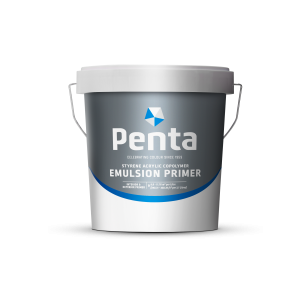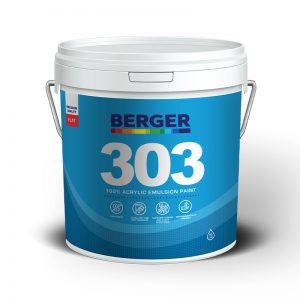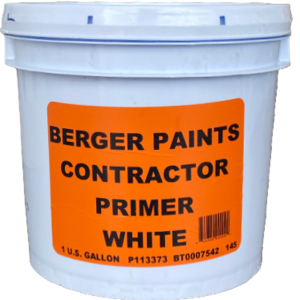Penta Flat Paint is based on an alkyd resin and provides a smooth flat finish suitable for interior surfaces not subject to hard wear, soiling or high humidity. Withstands occasional washing.
RECOMMENDED USES:
For interior surfaces not subjected to hard wear, soiling or high humidity. Can be used on masonry, wood, metal and mostnother suitably primed substrates. NB: Not for exterior use.
PRODUCT ADVANTAGES
• Good opacity
• Excellent hold out
• Hides Surface imperfections
SURFACE PREPARATION
NEW AND UNPAINTED: Ensure that surfaces are dry and cleaned free of all dirt, dust, grease, oil, wax, form oils, parting compounds, fungal and algal growth, and other debris and contaminants.
WOOD: New wood must be cured, dry and cleaned free of any dirt, oil, grease, exuded resin, soluble salts arising from preservative treatment etc. Fill all cracks, holes, crevices etc. with an appropriate wood putty or filler. Oil-based putties and fillers should not be used over primed wood
IRON AND STEEL: For normal exposure remove rust and millscale by hand tool cleaning (SSPC-SP2-82) or power tool cleaning (SSPC-SP3-82) to Swedish Standard St-2. Remove oil, grease etc. by solvent cleaning with Penta Thinner 41 to SSPC-SP1-82. For severe exposure (e.g. marine), blast clean to commercial standard, SSPC-SP6-82.
ALUMINUM: Thoroughly degrease with Penta Thinner 41.
NEW GALVANIZE: Thoroughly degrease to remove oils, grease, waxes etc. by solvent cleaning with Thinner 41 in accordance with SSPC-SP1-82. Remove non-oily soils and dirt by water-washing with scrubbing, using a nylon brush/broom. Partially soluble contaminants and clear water-sensitive chromate coatings may be removed by cleaning with a solution of ammonia or acetic acid, following by thorough rinsing with clean water. Sanding or brush sand blasting may be used to remove silicate and chromate treatments and also to roughen the surface, which is important for ensuring good adhesion.
WEATHERED GALVANIZE: Weathering of galvanize for at least 6 months will remove oils and many surface treatments, and provide a finely etched surface suitable for painting. Weathering is unpredictable, and the surface must therefore be thoroughly examined to ensure that the oxidized surface layer is uniform and tightly adherent. Scrub with water and a nylon brush to remove non-oily dirt and any water-soluble zinc salts, and loose, powdery white rust. Cleaning with a dilute solution of ammonia or acetic-acid may also be used to remove partially soluble zinc salts, but this must be followed by very thorough rinsing with clean water. Clean if necessary with Thinner 41, to remove any oily contaminants.
CHIPBOARD: Single layer, open-surface chipboards may require sanding and overall filling with oil or water-based fillers if a high standard of finish is required, but the surface must be primed first with an oil-based primer such as Penta Wood Primer Undercoat.
GYPSUM PLASTER: New plaster must be allowed to dry out thoroughly. Lime plaster required 30-60 days and other more popular plasters somewhat less. No paint or sealer should be applied if the moisture content exceeds 8%. Plaster nibs should be scraped and sanded smooth. Cracks should be spackled and smoothed.
GYPSUM WALLBOARD: Ensure all surfaces are dry and cleaned free of dirt, dust etc. Do not use linseed oil putty, glazing, patching pencil, caulking compounds or masking tape on surfaces to be painted.





